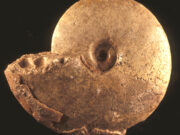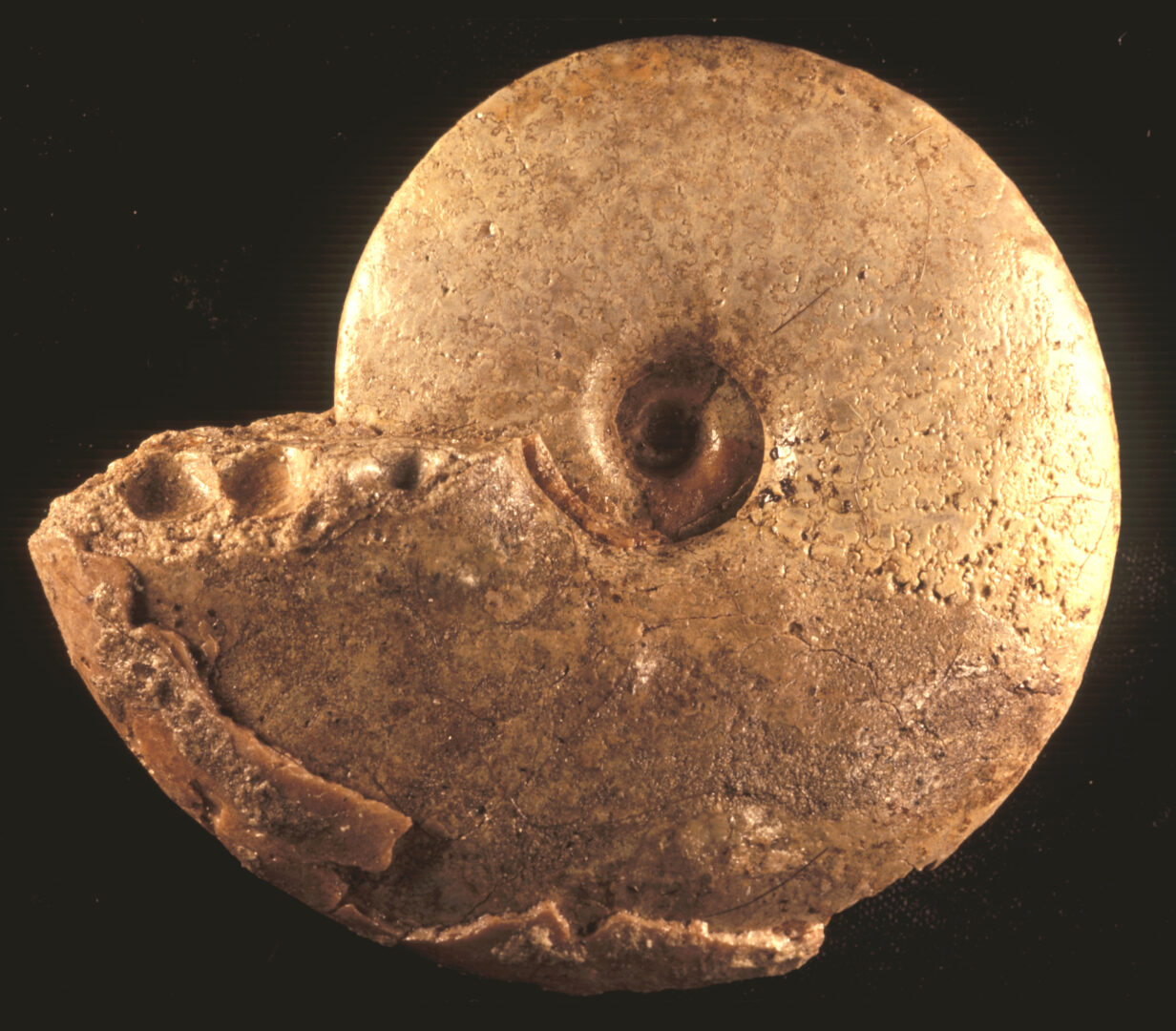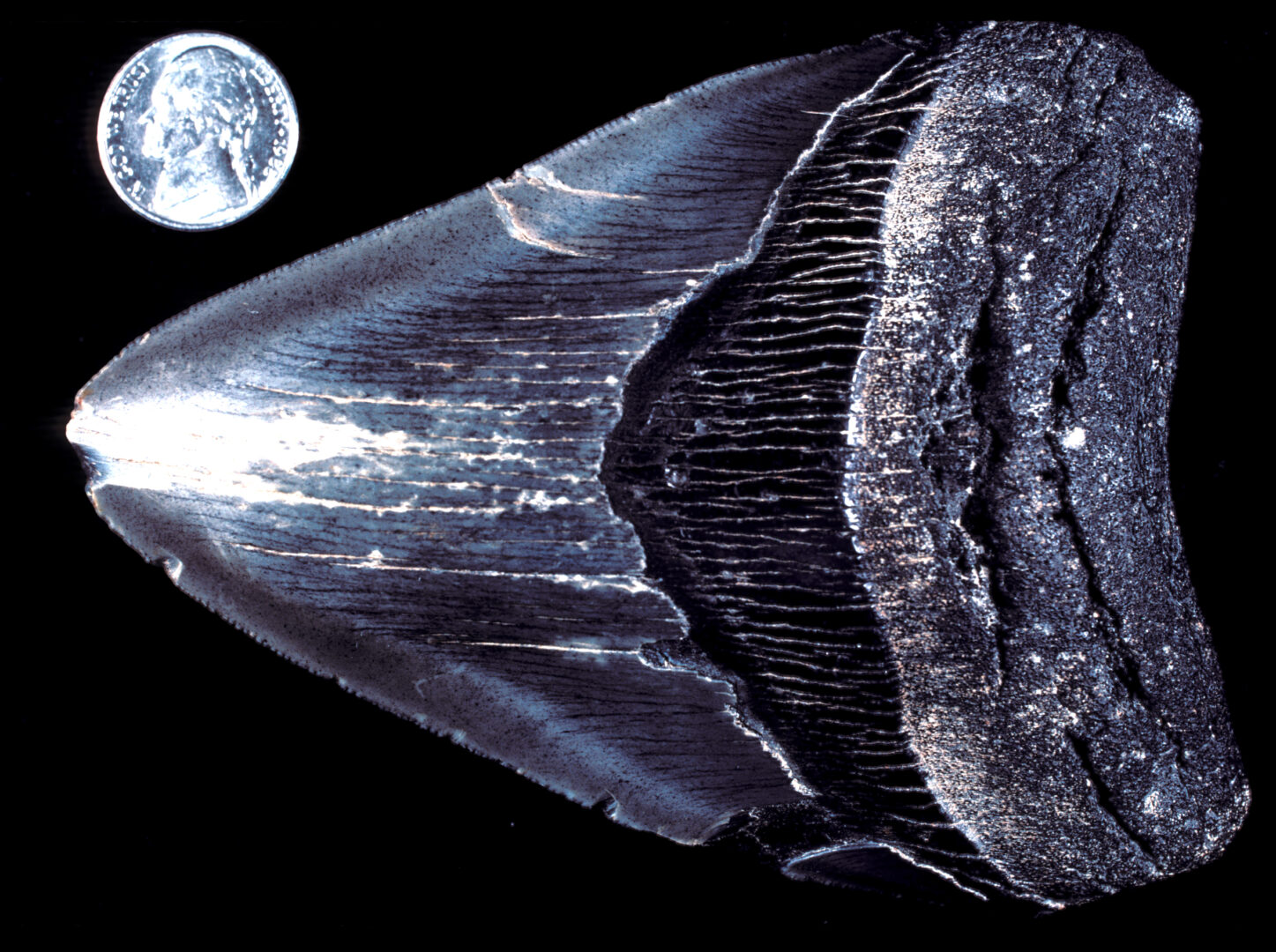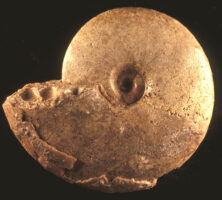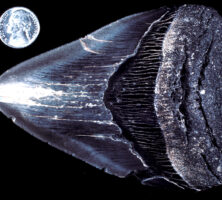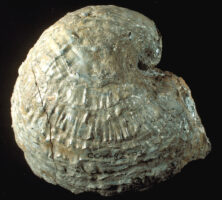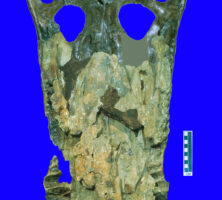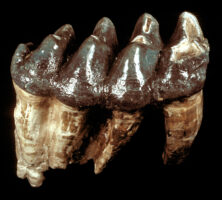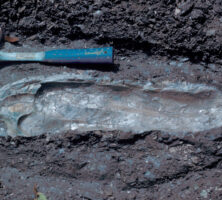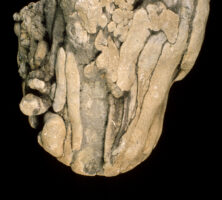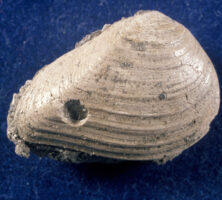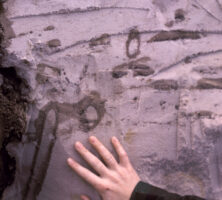Sedimentary deposits of Georgia’s Coastal Plain cover more than half the state and contain abundant fossils of both vertebrates and invertebrates. The ages of these fossils range widely, from the Late Cretaceous through the Pleistocene (Ice Age).
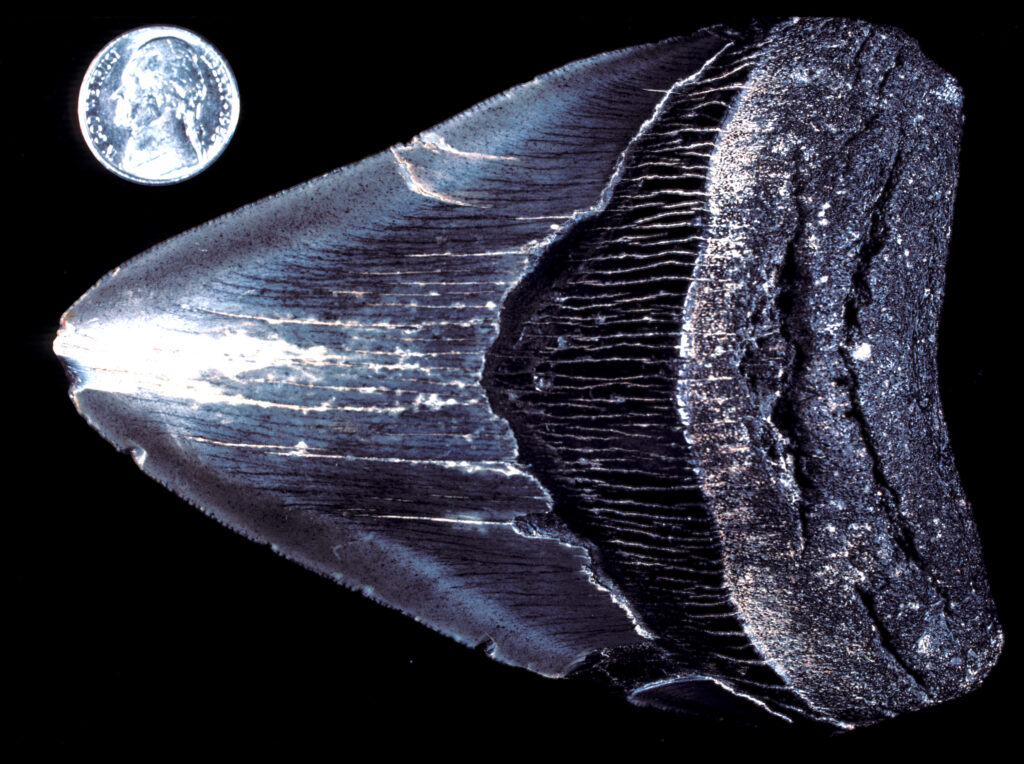
Photograph by David R. Schwimmer
The oldest Coastal Plain fossils are found farthest inland, reaching to the fall line, where the Piedmont meets the Coastal Plain. Sequentially younger fossils tend to be located closer to the present coasts, following the younger ages of sediments. However, some of the youngest fossils (from the Late Paleogene and Pleistocene) are also found in deposits lying on top of older sediments.
An overriding influence on Coastal Plain fossils is the nature of the Coastal Plain itself. The majority of fossil-bearing Coastal Plain deposits formed along the coast in bays and estuaries or in shallow, offshore ocean sites. These deposits were laid down during times when the oceans were much higher. Because of this marine influence, the majority of Coastal Plain fossils represent sea life; it is not surprising that the state fossil is a giant shark tooth. Across the Coastal Plain, far from the present shoreline, many types of sharks, bony fish, marine reptiles, and marine mammals are amply represented. The fossils of many terrestrial animals are also found in marine deposits, probably as a result of the animals being transported or drowned.
Invertebrate marine fossils are also abundant in the sedimentary rocks of the Coastal Plain. Most abundant are the shelled sea-life of nearshore habitats, with bivalved mollusks dominating. Because these deposits are relatively young, many of the invertebrates are similar to modern forms, although fossils of extinct invertebrates can be found in the Cretaceous deposits.
The Late Cretaceous sediments date from 86 to 67 million years of age and represent the earliest encroachment of the Gulf of Mexico and Atlantic Ocean on the eroding Piedmont. These sediments consist mostly of coarse sand and gravels, but as the coastal deposition of the Late Cretaceous continued, the sediments changed to silty, muddy sands. The Late Cretaceous deposits formed in bays, lagoons, and estuaries along the Georgia coast, reaching diagonally across the southeastern third of the state. Subsequent deposits of the Paleogene period tend to contain more clay and limestone because of the increasing distance from the eroding Appalachian roots and the warm climate intervals, which favored carbonate deposition (as seen in modern south Florida and the Bahamas). The pattern of these deposits generally follows the gradual buildup of material from land to sea, toward the south-southeast, pushing the coast increasingly seaward over time. However, during several intervals of the Paleogene period, sea level rose high enough to flood the entire southeastern half of the state, leaving broad areas with younger deposits over older ones.
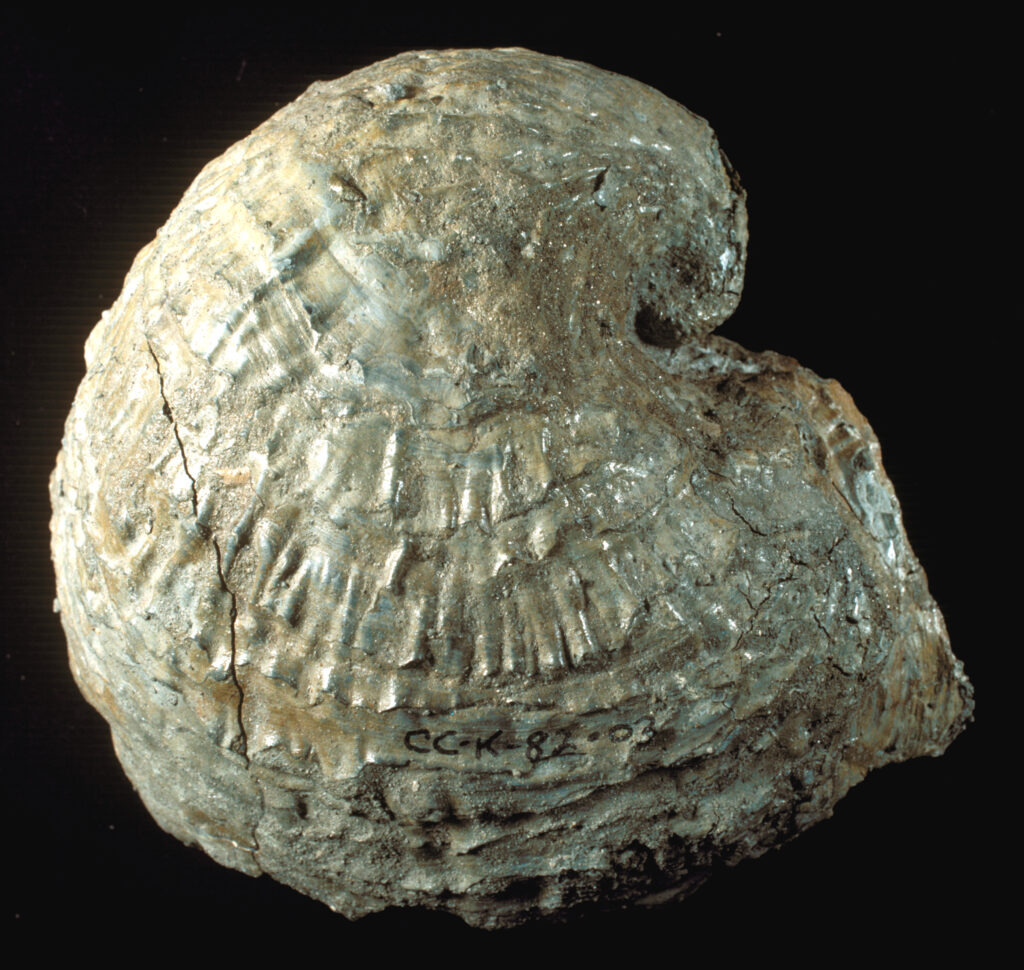
Photograph by David R. Schwimmer
Vertebrates
Cretaceous Fossils
Found in the inner Coastal Plain, the oldest fossils include several types of dinosaurs. The fossil-bearing deposits range from 87 to 66 million years of age. The best Late Cretaceous fossil beds are located in a small area at the far western border of the state, along the valley of the Chattahoochee River and its tributaries in Chattahoochee and Stewart counties. Sandy sediments in these exposures contain abundant goblin shark teeth and sea turtle shell fragments. Less common fossils include vertebrae, teeth, and scales of bony fish.
The most impressive Cretaceous fish remains come from a species of giant “bulldog” fish, whose teeth reached lengths of 7 centimeters. The fish itself grew up to 4 meters long. Also common are the jaw parts and vertebrae of a schooling fish genus, which are easily recognized because of their fangs with curved bony bases.
The sedimentary deposits in some sites are packed with microscopic parts of marine vertebrates, especially shark skin denticles, sawfish teeth, bony-fish scales, and the tiny button-like teeth of pycnodonts (a group of early bony fish). As of 2006 more than 35 species were found as microscopic fossils. Surprisingly no Cretaceous mammal teeth have been found in Georgia.
The fossils of marine reptiles are also present. The vertebrae and teeth of both mosasaurs (large marine lizards) and plesiosaurs (long-necked reptiles) are moderately common fossils. Some of the most noteworthy fossils found in the nearshore Cretaceous deposits are rare nonmarine animals, including freshwater turtles, primitive alligatoroids, and dinosaurs. Three dinosaur groups that have been identified from the Late Cretaceous period in Georgia include hadrosaurs (duck-billed dinosaurs), a single species of tyrannosaur (a smaller relative of Tyrannosaurus), and a single ornithomimosaur (an ostrichlike dinosaur). Few of the dinosaur fossils are complete enough to identify genus and species, but the tyrannosaur has been extensively studied and named a new genus, Appalachiosaurus, unique to the southeastern Coastal Plain.
Another significant large animal presence on the Late Cretaceous Georgia coast was a gigantic crocodylian, known to reach lengths of 9 meters and weights of 2.8 tons. Teeth, vertebrae, and skull bones from these primitive alligatoroids are more common on the coast of Georgia than in any other known area, and the animals were bigger than the largest known carnivorous dinosaur of the region. They were probably the top predators on the Georgia coast from 82 to 75 million years ago.
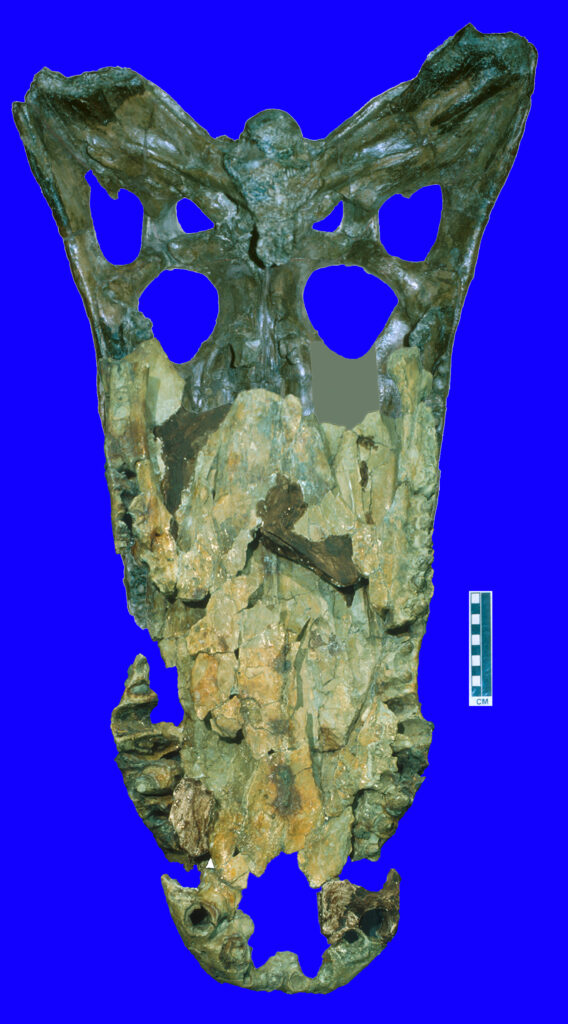
From King of the Crocodylians, by D. R. Schwimmer. Reproduced by permission of David R. Schwimmer
Some of the rarest Late Cretaceous Coastal Plain fossils are the scant remains of pterosaurs (flying reptiles) and birds. Only three identifiable bones of an ornithocheirid pterosaur have been formally reported, from a single site in Chattahoochee County. However, small fragments of other pterodactyloid pterosaurs are known from many regional fossil beds. Similarly, fragments of bird bones are found but rarely well enough preserved to allow firm identification. These difficulties in identification result from the very thin, fragile bones of these flying animals, which do not preserve well in the harsh marine environments of the typical Coastal Plain bone beds.
Paleogene and Neogene Fossils
The largest area of the Georgia Coastal Plain is covered by sedimentary deposits of the Paleogene and Neogene periods, ranging from about 63 to 2 million years ago. As with the Cretaceous units, most of these sediments were deposited in marine environments; however, many more open-ocean deposits are represented in these deposits than in the Cretaceous sediments, and the most common vertebrate fossils contained within them are sharks and bony fish. Also present is the large shark Carcharocles megalodon. Large marine reptiles or dinosaurs became extinct at the end of the Cretaceous, so their fossils do not appear in the Paleogene or Neogene deposits. The Coastal Plain is world famous for its fossils of early whales, which appeared in the Eocene Epoch.
Shark and ray teeth are common throughout the Paleogene and Neogene deposits across the Coastal Plain. In the older Paleocene through Oligocene deposits, found across the mid-Coastal Plain, the most common shark remains are teeth and vertebrae of mackerel, mako, and sand sharks. The deeply serrate teeth of the ragged-toothed shark are also present, as well as early species of the giant Carcharocles lineage, C. auriculatus, which appeared in the Eocene. Fragments of the dental pavements and stingers of eagle rays are abundant beginning with the Eocene and Oligocene deposits, allowing collectors to distinguish these fossil collections from those of the Cretaceous.
In the Miocene and Pliocene epochs, the hammerhead, tiger, bull, and white sharks were common. It was also during this time that Carcharocles megalodon appeared, leaving its unmistakable giant teeth and vertebrae. Miocene-Pliocene deposits are commonly found near the coast and in fact are often dredged during channel-clearing work along coastal areas of the state. Blackened shark teeth, commonly found on the Georgia coastal islands, likely come from buried Miocene-Pliocene deposits exposed by modern erosion or dredging.
The Eocene whale fossils are not as common as those of fish but are very important because they include species from the early stages of whale and dolphin evolution. Several specimens of a typical early whale have long been known from the Middle Eocene of Georgia. At this stage of evolution, whales had serrated cutting teeth, vestigial hind limbs, and only partly developed underwater hearing adaptations. Recently, much of the skeleton of an even more primitive Eocene whale was discovered in Burke County.
Whale fossils are also found in Miocene and Pliocene deposits but are usually represented by single teeth and bones, especially vertebrae, and solid ear ossicles. Ossicles are oddly shaped ear-bones that form part of the sound-conduction system of advanced whales and show that these Paleogene whales were close to modern forms. However, a common group of Miocene whales, the cetotheres, did not swim as fast as modern baleen whales and may have been the principal prey of the huge Carcharocles megalodon; the sharks and the whales went extinct at about the same time during the late Miocene to early Pliocene.
Terrestrial vertebrate fossils older than the Ice Age are very rare on the Coastal Plain, since so much of the sediment is marine in origin. However, at least one report exists of primitive horse fossils found in Pliocene upland sand and gravel in Taylor County.
The Pleistocene Epoch (Ice Age) fossils of the Georgia Coastal Plain are difficult to date with atomic decay techniques but may be anywhere from 2 million to 11,000 years old. They are abundant and have been collected since the early nineteenth century. Pleistocene vertebrates are most commonly found in rivers, canals, and channels in and around the Georgia Sea Islands, as well as in the tidal marshes around cities from Savannah to Brunswick, especially at low tides. Ice Age fossils also occur in superficial deposits as far west as the Chattahoochee River on the Alabama border, probably from high sea-level events between glaciations.
Unlike older fossils, many of the Pleistocene vertebrates in Georgia were terrestrial mammals and included representatives of several large-animal groups that are now extinct or absent from the Americas. Among the earliest discoveries were the remains of several types of giant ground sloths. Ground sloths, along with many other edentates, or “toothless” mammals, were common in the Ice Age coastal areas. Other Pleistocene edentates include the large, solid-shelled glyptodonts, which are much less common than sloths; smaller armadillos; and an extinct giant armadillo, with a carapace measuring more than two meters long.
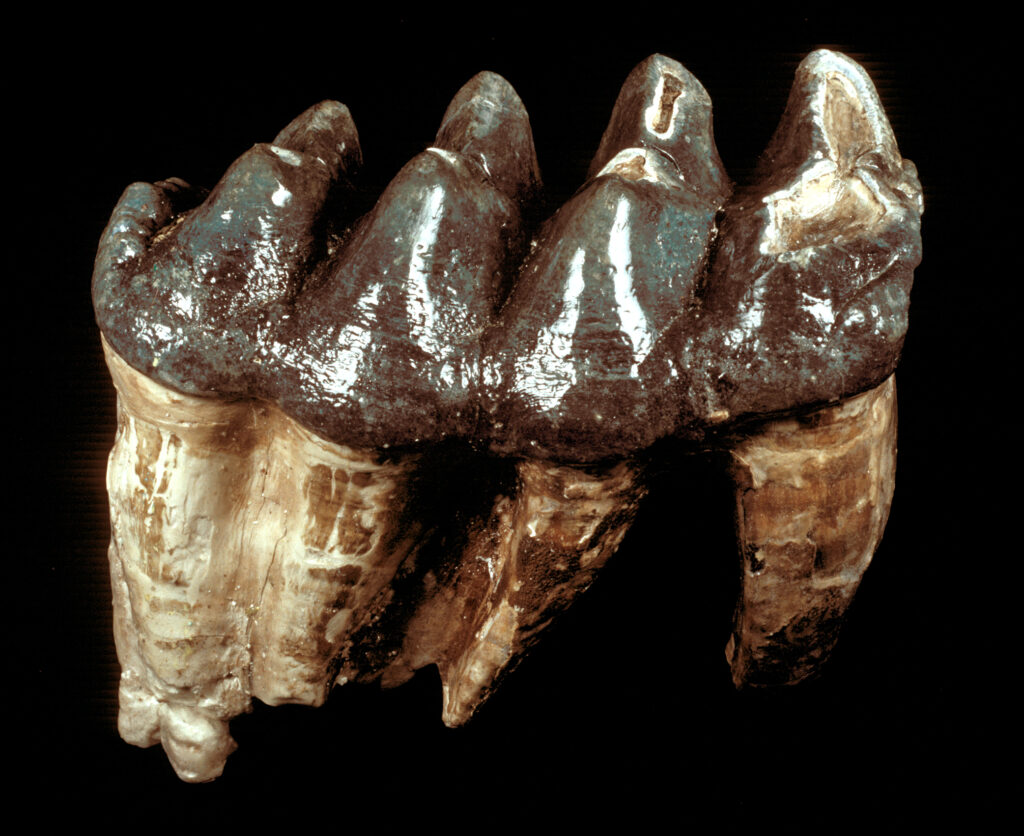
Photograph by David R. Schwimmer
Mammals with trunks (proboscideans) from the Coastal Plain include both mastodons
Among the Ice Age mammal fossils are remains of many species either similar to or nearly identical to living species. These include three species of horses as well as species of deer, bison, tapirs, and beavers.
A complete faunal list of late Pleistocene fossils from Georgia may include more than 100 species of vertebrates. In addition to land mammals from bears to mice, Pleistocene deposits at the coastal areas contain remains of marine, salt-marsh, and river animals, with many modern species of sharks (including the modern great white shark), stingrays, catfish, many other bony fish, turtles, tortoises, amphibians, and both the American alligator and the American crocodile. Marine Pleistocene deposits also contain remains of porpoises and whales, mostly of modern species.
The date at which humans first entered the Georgia Coastal Plain is currently a matter of debate. Artifacts of cultures traditionally dated to 9,000 years of age are widespread in Georgia, and there is some evidence that the earliest humans in the area were hunting mastodons or other very large mammals by the Late Pleistocene.
Invertebrates
Mollusks
Mollusks are the most generally successful invertebrate phylum preserved in Coastal Plain deposits of the last two geological eras (the Mesozoic and Cenozoic). Among mollusk classes, bivalves, including oysters, mussels, and clams, tend to be dominant in the shallower seas, while cephalopods, including squids, octopuses, and some shelled forms, were the top invertebrate predators of the open seas. In all marine habitats snails were present and are sometimes abundant in fossil deposits.
Bivalves
From Late Cretaceous to modern times, the most characteristic invertebrates of the Georgia coast were and are oysters, which as a group are well suited to sandy coastal habitats. The most diverse oysters throughout the Coastal Plain are species related to the modern eastern Atlantic oyster, including two earlier species that were long and very large. The Late Cretaceous Crassostrea cusseta reached 60 centimeters, and the similar Eocene C. gigantissima was only slightly smaller. Crassostrea gigantissima shells are abundant in the exposures of Eocene sediments at Shell Bluff, on the Savannah River in Burke County.
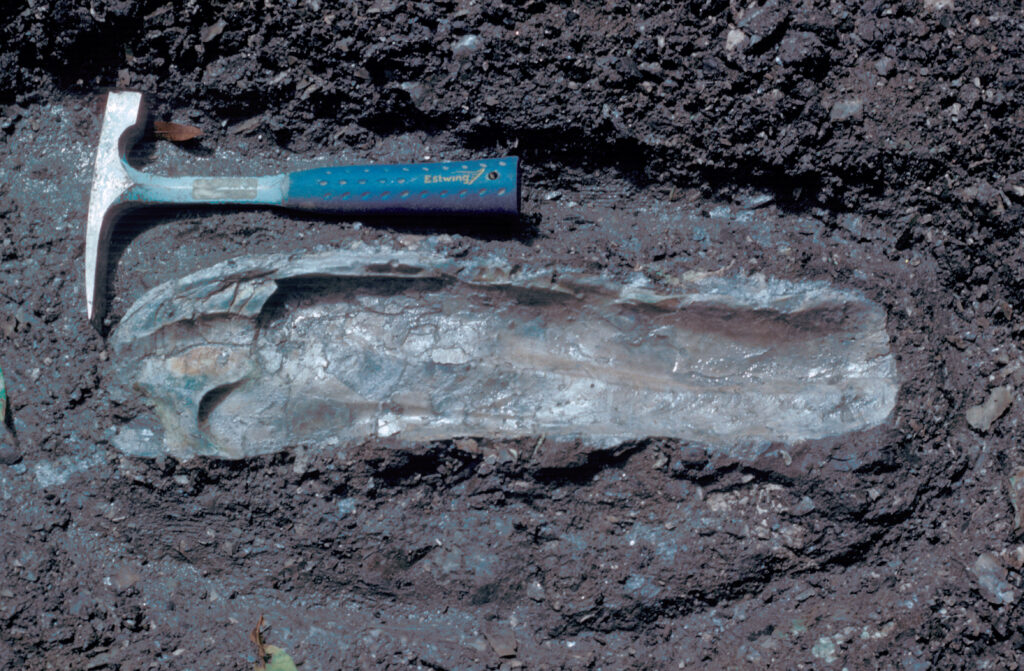
Photograph by David R. Schwimmer
Several extinct oyster lineages stand out as noteworthy fossils. The Late Cretaceous genus Exogyra is often so abundant that in some sites fossils can be collected by the bushel. Five species of Exogyra are found in Georgia in well-constrained evolutionary sequences, and their occurrences can be used to date the enclosing sediments within 4 million years. Related gryphaeid oysters are also found in Late Cretaceous to Early Paleogene deposits in Georgia.

Photograph by David R. Schwimmer
Other common bivalved mollusks include clams similar to modern Atlantic and Gulf species, present throughout the time of Coastal Plain deposition. Especially noteworthy among these are rock- and wood-boring clams. Many thick-shelled Coastal Plain fossils of all ages show holes of about 0.5 to 1 centimeter in diameter that were bored by clams. Some hole-boring clams are typically found in Paleogene coral. In addition to holes in shells, Late Cretaceous fossil wood, preserved as lignite or coal, is often riddled with holes from “shipworms,” which are actually clams.
Cephalopods
Cephalopods are active, predatory mollusks with tentacles, complex paired eyes, and in some groups, shells. The shelled cephalopods are the most common to be found as fossils. Among these, two groups are found in Coastal Plain deposits: the extinct ammonites of the Late Cretaceous, and the nautilids, which still exist and reach back to well before the Mesozoic.
Ammonites can be spectacular fossils, with their mother-of-pearl shell material often showing rainbow refraction colors, and with sizes reaching more than a meter in diameter. The shells are complexly subdivided by partitions and are straight, helical, slightly irregular, or most often coiled in a planispiral. Unfortunately, the shells of ammonites are thin and composed of aragonite, an unstable form of calcium carbonate that was usually poorly preserved in the acid sediments of west Georgia, and so they are often flattened and decomposed. However, a few sites in Chattahoochee and Stewart counties contain Late Cretaceous limestones that have preserved ammonite shells.
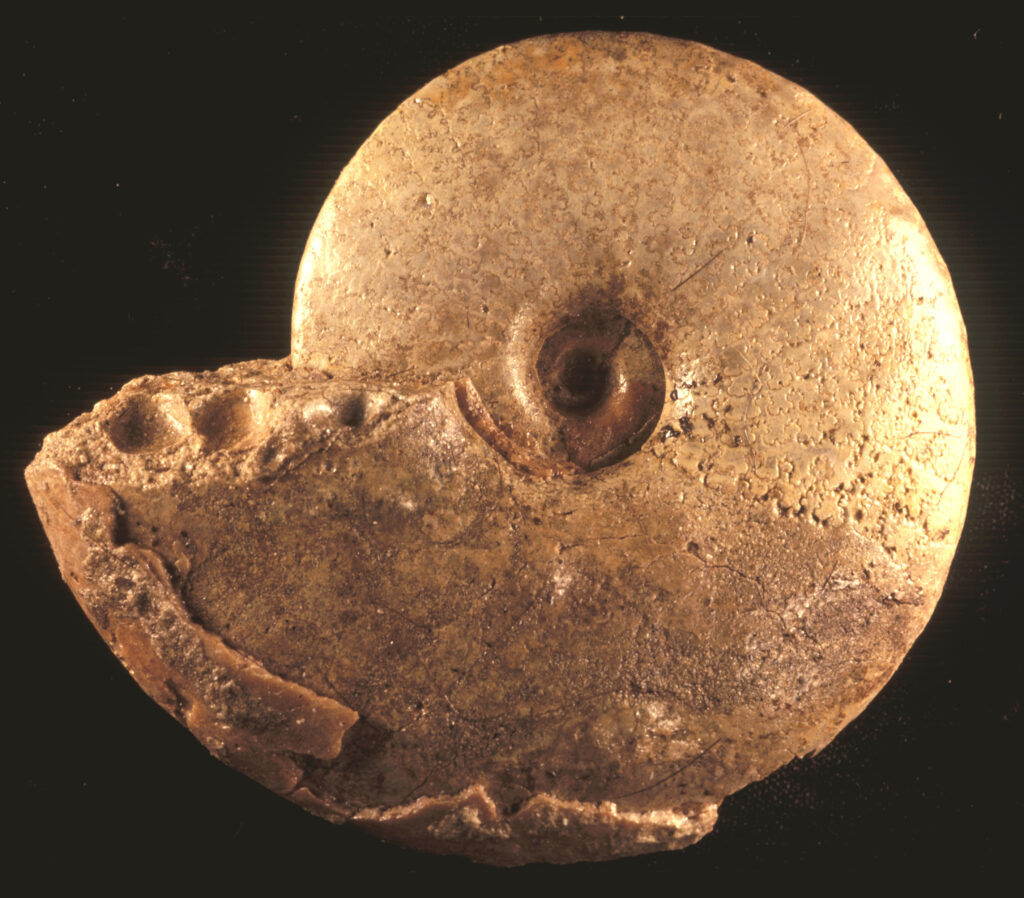
Photograph by David R. Schwimmer
Nautilids are distantly related to ammonites, and the shells may appear superficially similar, but the last common ancestor of the two groups existed more than 400 million years ago. They differ in the makeup of the shell septa and in many internal shell features. Nautilids as a group are still extant and have not changed significantly from forms found since the Late Cretaceous; thus the modern Nautilus is a “living fossil.” Nautilid fossils in the Late Cretaceous of the genus Eutrephoceras and later fossils of Nautilus are moderately common, with some of their coiled shells as large as soccer balls.
Gastropods
Snails are ever-present mollusks in the oceans and have been abundant for the past 500 million years. Only in unique habitats are they the dominant forms, and their aragonitic shells often preserve poorly. Nevertheless, there are dozens of gastropod genera in Coastal Plain sediments, especially in the Paleogene and Neogene deposits; to the nonspecialist, they appear to have changed little from Late Cretaceous to modern times.
A few easily recognizable groups on the Georgia Coastal Plain are the high-spired turritellids; the simple slipper shells; the large, elongated conchs and whelks; and the showy Ecphora and Pleistocene Murex. The naticids, including moon snails, are especially important, not because of their fossil shells, but because of their predatory drilling, which left circular, tapered holes in other mollusks, especially bivalves. These holes may be traced back to the Late Cretaceous and became commonplace in younger bivalve fossils; indeed, snail drillings are the most frequent cause of mortality in many clam species.
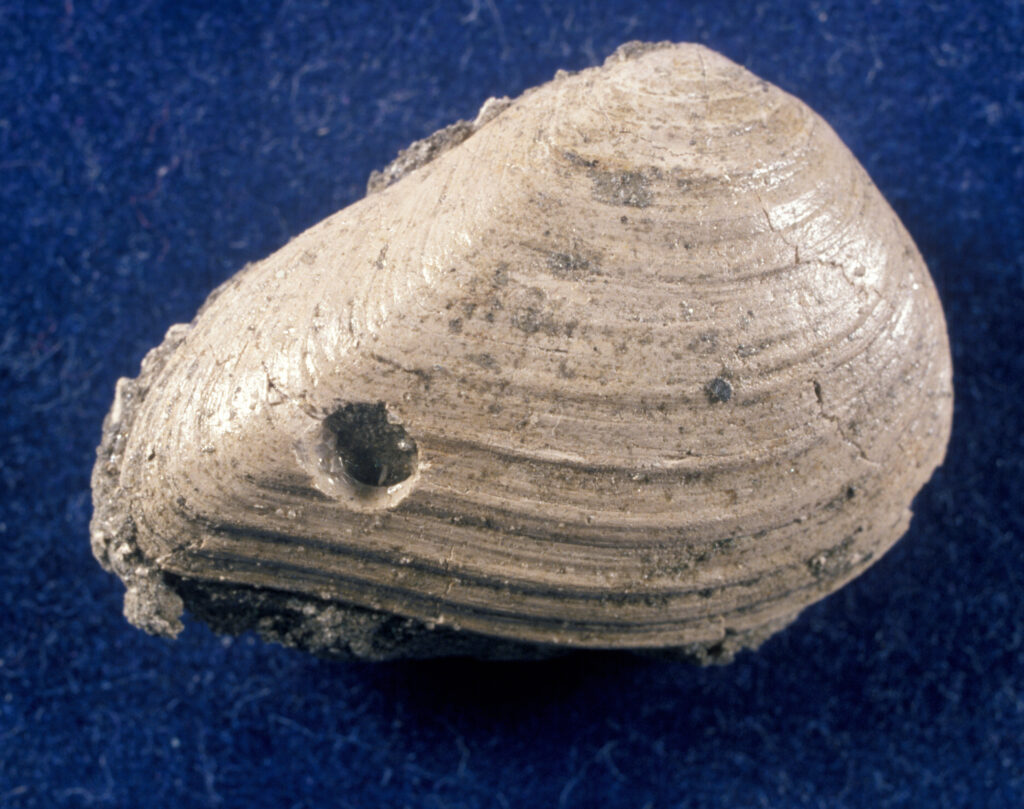
Photograph by David R. Schwimmer
Arthropods
Crabs first became abundant during the Late Cretaceous, and fragments of crab claws and carapace are common almost anywhere Coastal Plain fossils are preserved. Complete crab fossils are rare, however, except in unusual preservations. One such example is the Late Cretaceous Ripley Formation near Fort Gaines, which contains abundant complete specimens of the spider crab. These apparently died in mass quantities in episodes of anoxic marine conditions.
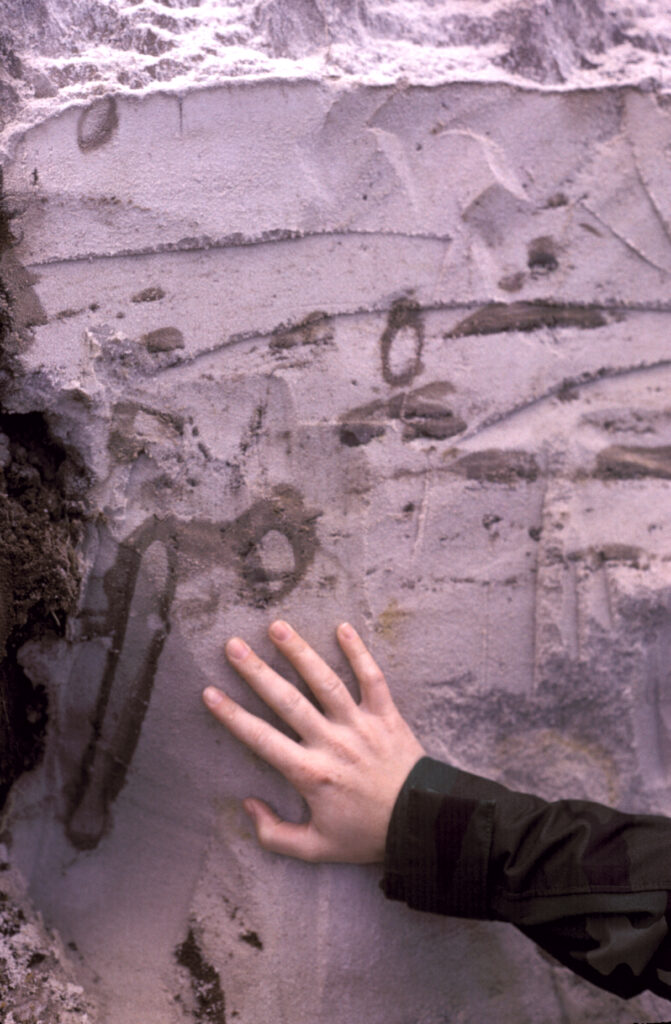
Photograph by David R. Schwimmer
Crabs and shrimps are also commonly represented by infilled burrows in sandy deposits. Like modern ghost crabs, earlier crab species made elaborate burrows about one meter deep in beach sands on the ancient barrier bar islands that formed along the Georgia coasts. Another crustacean group, the burrowing intertidal shrimp of the family Callianassidae, are usually represented by traces of their activities rather than by body fossils. Their vertical or J-shaped, lumpy burrows are present in nearly all low-tidal sandy deposits of the Coastal Plain, from the Late Cretaceous to present times.
Echinoderms
Echinoderms include starfish, sea cucumbers, brittle stars, crinoids, and echinoids (sea urchins and sand dollars), with only the last group having a significant fossil record on the Coastal Plain. Echinoids feature a substantial calcite skeleton with a five-part structure serving both their locomotor and vascular systems. Spiny sea urchins are typically found on rocky shores and hard-bottomed environments, whereas the more streamlined heart urchins and sand dollars were common in intertidal and slightly deeper-water sandy environments.
Many types of echinoids are common in Coastal Plain deposits. They are especially well represented in the Eocene Ocala Limestone in the central Coastal Plain, but sea urchins were also common back to the Cretaceous and earlier times. Urchins are locally abundant on hard sandstones in Late Cretaceous deposits in west Georgia. In later deposits, one often finds isolated spines in sedimentary deposits from the coarse-spined regular urchins of the order Cidaroidea. Irregular heart urchins and sand dollars are typically found in the Eocene and younger sediments.
Coral and Miscellanea
A few common invertebrate groups are represented in the Coastal Plain as only a few common species, but often with numerous individuals. These include certain corals, sponges, and polychaetes (marine worms). Coral might seem common, but the coast of Georgia was largely too sandy and muddy for coral reefs to develop successfully. Some poorly preserved colonial coral are found in Miocene deposits in south-central Georgia, often heavily bored by sponges and clams. Small, solitary coral skeletons are common in many sedimentary deposits, and these include species of Flabellum in the Late Cretaceous and Paleogene, and Endopachys in the Paleogene and Neogene.
Sponges, which are among the simplest animals, are as rare as body fossils but ubiquitous as trace fossils because of the boring habit of the Clionid family. These small, elongate sponges spend their lives boring and occupying holes in mollusk shells for nourishment and habitat. Indeed, many bivalve and clam shells are so riddled with sponge borings that the fossils are more hole than shell.
Wormlike fossils can represent many invertebrate groups, including boring clams; elongate, tortuously twisted shells of gastropods; and the tubes of certain segmented worms. Many fossil shells of Neogene age, especially large gastropods, are found with carbonate tubes encrusting the surfaces, each of which housed a worm of the genus Serpula.


